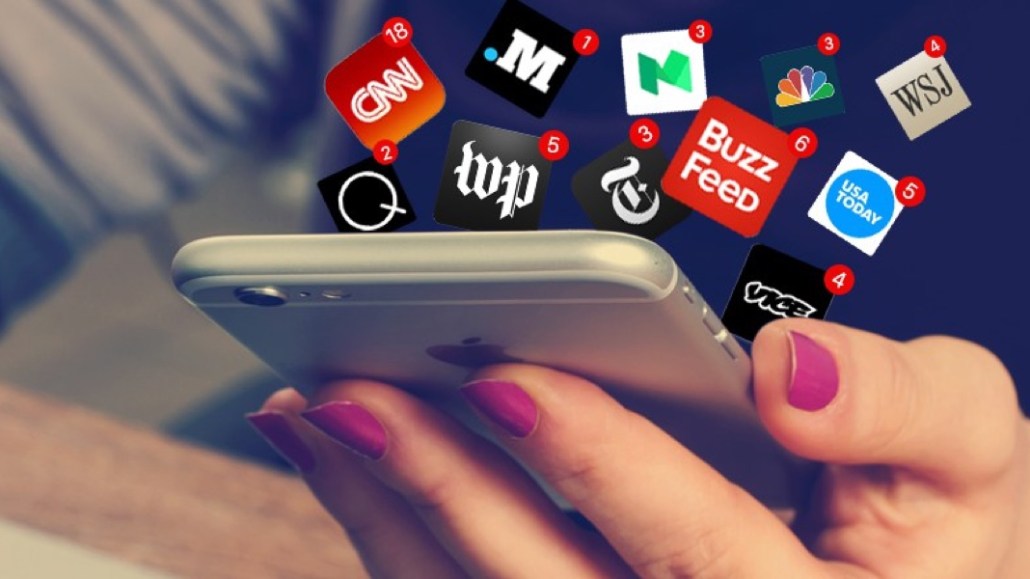Save 50% on a 3-month Digiday+ membership. Ends Dec 12.
Publishers eye push notifications in aftermath of Facebook news feed changes

If you’re wondering why you got the same Apple News push alert from CNN a half-dozen times Tuesday afternoon, it wasn’t a coincidence. (CNN said it was an Apple News glitch, something Apple confirmed later.)
Now that Facebook is deprioritizing publishers’ posts in the news feed, there’s more urgency for publishers to make direct connections with readers. That means they’re taking push notifications more seriously.
The Wall Street Journal has tripled, to nine, the number of topics that its mobile app users can follow and made it possible to “follow” its writers so users get a push when those authors publish something.
Publishers are making an effort to stand out visually. Gannett’s USA Today grew its referral traffic from pushes by 18 percent by incorporating pictures, video and GIFs into its messages. The Guardian has played with the font and style of its push notifications. CNN is will begin adding rich media to its push notifications in the second quarter of 2018.
And while personalized push notifications didn’t gain much traction among publishers’ app audiences last year, publishers including Gannett are looking to infuse more personalization into the pushes they send. In a survey Gannett conducted with its app users last year, relevance of the content was named as a top motivation for responding to push notifications.
“If they don’t identify with it, they’re less likely to engage with it,” said Larry Aasen, director of mobile development at Gannett.
These moves were already in the works when Facebook announced changes to its news feed algorithm earlier in January. But as publishers try to make up for the loss of reach in the news feed, even areas that drive small amounts of referral traffic will become more important.
“You’re seeing a lot more sophistication,” said Mike Herrick, svp of product and engineering at Urban Airship, a push notifications technology provider. “The assets that are owned are going to be the most strategic.”
Publishers pay close attention to their app audiences because their response to a story often provides a good signal for how a publisher’s broader audience will react to it. At CNN, for example, the click-through rate on its app push notifications determines whether to move breaking stories to the top of its homepage or write more stories on a developing story.
“They’re optimal for getting an early indication for how a story is playing with your audience,” said S. Mitra Kalita, CNN’s vp of digital programming. “I used to use Facebook metrics like this over five years ago. You’d look at shares over the course of 20 minutes.”
The competition for space on users’ phone lock screens has gotten intense. The volume of push notifications sent by publishers rose more than 50 percent from January to December in 2017, according to data from Urban Airship. While there’s a risk that publishers will overdo it, audiences are getting used to a fire hose of notifications: Opt-in rates for push notifications rose 16 percentage points this year, also according to Urban Airship.
Pete Brown, a senior research fellow at the Tow Center for Digital Journalism and the author of “Pushed Beyond Breaking,” a research report on push notifications published last fall, predicts that images, automation and personalization will gain importance in pushes. Last week, Urban Airship rolled out a tool that will allow publishers to use artificial intelligence to schedule push notifications based on when the audience is most likely to interact with them.
Push notifications account for a small percentage of most publishers’ overall traffic. For USA Today, they drive just 10 percent of its mobile app opens and 5 percent of the mobile app’s pageviews.
Yet those slivers of audience are valuable. To receive a push notification, a person must have either downloaded a publisher’s app or followed the publisher inside a platform like Apple News or Google Play Newsstand, a sign of affinity.
“A lot of people would consider their push audience their most loyal, their most engaged audience,” Brown said.
More in Media

As big brands flood the podcast ad space, startups are refining strategies to stand out
While a influx of big advertisers is good news for podcast companies, it also makes it more challenging for small- to mid-sized brands to stand out in the space.

Meta enters AI licensing fray, striking deals with People Inc., USA Today Co. and more
The platform has secured seven multi-year deals with publishers including CNN, Fox News, People Inc., USA Today Co to incorporate their content into its large language model (LLM) Llama.

European publishers say the Digital Omnibus ‘cookie fix’ leaves them worse off
The European Union’s attempt at a legislative spring clean for Europe’s web of data privacy rules, has landed flat with publishers.








